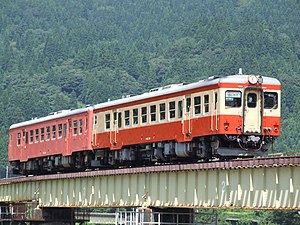KiHa 52
| KiHa 52 | |
|---|---|
 Two JR West KiHa 52 DMU cars on the Oito Line in 2008 | |
| In service | 1958-1987 (JNR) 1987-2010 (JR) 2011- (Isumi) 2012- (PNR) 2007- (Myanmar Railways) |
| Constructed | 1958-1966 |
| Number built | 112 |
| Number preserved | 2 |
| Fleet numbers | KiHa 52 1 - 56 KiHa 52 101 - 156 |
| Operators | Philippine National Railways Isumi Railway Myanmar Railways |
| Depots | Tutuban, Naga |
| Lines served | Metro South Commuter Bicol Commuter Mayon Limited (currently Isarog Limited Express) Isumi line |
| Specifications | |
| Car body construction | Steel |
| Entry | Step |
| Doors | 2 single-leaf sliding doors per side |
| Coupling system | AAR coupler |
| Track gauge | 1,067 mm (3 ft 6 in) |
The KiHa 52 (キハ52形) is a Japanese diesel multiple unit (DMU) type formerly operated by Japanese National Railways (JNR), JR Group companies, and later by the private operator Isumi Railway in Japan, Myanmar Railways, and Philippine National Railways (PNR).
112 KiHa 52 cars were built for Japanese National Railways between 1958 and 1966. The design was based on the KiHa 20 series "general purpose" DMU type, but with two engines for use on mountainous lines.[1]
Variants
- KiHa 52 1 – 56: Built 1958–1962[2]
- KiHa 52 101 – 156: Built 1963–1966[2]
- KiHa 52 651: Converted from KiHa 52 101[2]
Livery variations
JNR-era liveries
-
JR West KiHa 52 115 in original JNR two-tone livery, March 2007
-
KiHa 52 156 in "metropolitan" all-over red livery, August 2009
-
KiHa 52 125 in JNR two-tone blue & beige livery, August 2008
JR-era regional liveries
-
KiHa 52 114 in JR Kyushu livery, August 1993
-
KiHa 52 125 in "Oito Line" livery, December 1999
-
JR East KiHa 52s in "Morioka" livery, August 2006
-
A JR East KiHa 52 in "Niigata" livery, September 2008
Resale
Following withdrawal of the last remaining examples operated by JR West, one car, KiHa 52 125, was resold to the private operator Isumi Railway in Chiba Prefecture in April 2011. This unit was built in 1965, and formerly operated on the Etsumi-Hoku Line and Ōito Line in the Hokuriku region until 2010.[1]
-
KiHa 52 125 in JNR two-tone blue & beige livery in May 2011
-
KiHa 52 125 in May 2011 after repainting into original JNR two-tone vermillion & beige livery
Overseas operations
Myanmar

Philippines
Seven former JR East KiHa 52 cars originally based at Niitsu Depot were donated in September 2011 to the Philippine National Railways (PNR), where they are used on commuter services in the Manila area.[3]
As of October 2013, the trains are normally operated as two 3-car formations. The seventh car, KiHa 52 123, in Niigata livery, was taken out of service after operating for only seven months, and is stored at Tutuban Depot as a source of spare parts for the rest of the fleet.[3]
Formations
The two three-car sets are referred to as "KIHA-O" (for orange) and "KIHA-B" (for blue), reflecting the liveries they carry, and are formed as shown below,[3] with cars 52-137 and 52-121 at the Alabang end.
| KIHA-O | 52-137 | 52-127 | 52-122 |
|---|---|---|---|
| KIHA-B | 52-121 | 52-120 | 52-102 |
The former toilets in each car are locked out of use.[3]
Preserved examples

In addition to KiHa 52 125 operated on the Isumi Railway, two Kiha 52 cars are preserved in Japan, as listed below.[4]
- KiHa 52 115: Former Tsuyama Depot roundhouse, Tsuyama, Okayama
- KiHa 52 130: Osumi Line Memorial Park, Shibushi, Kagoshima
References
- ^ a b Kusamachi, Yoshikazu (January 29, 2014). いすみ鉄道のキハ52、3月から「首都圏色」に. Response (in Japanese). Retrieved June 14, 2014.
{{cite web}}: Unknown parameter|trans_title=ignored (|trans-title=suggested) (help) - ^ a b c JR全車輛ハンドブック'92. Japan: Neko Publishing. 1992. p. 296.
{{cite book}}: Unknown parameter|trans_title=ignored (|trans-title=suggested) (help); templatestyles stripmarker in|title=at position 1 (help) - ^ a b c d Saito, Miko (March 2014). フィリピン国鉄南方線の日本型車両. The Railway Pictorial (in Japanese). 64 (887). Japan: Denkisha Kenkyūkai: 64–72.
{{cite journal}}: Unknown parameter|trans_title=ignored (|trans-title=suggested) (help) - ^ Sasada, Masahiro (September 2012). 国鉄&JR保存車大全. Tokyo, Japan: Ikaros Publications Ltd. p. 129. ISBN 978-4863206175.
{{cite book}}: Unknown parameter|trans_title=ignored (|trans-title=suggested) (help); templatestyles stripmarker in|title=at position 1 (help)









